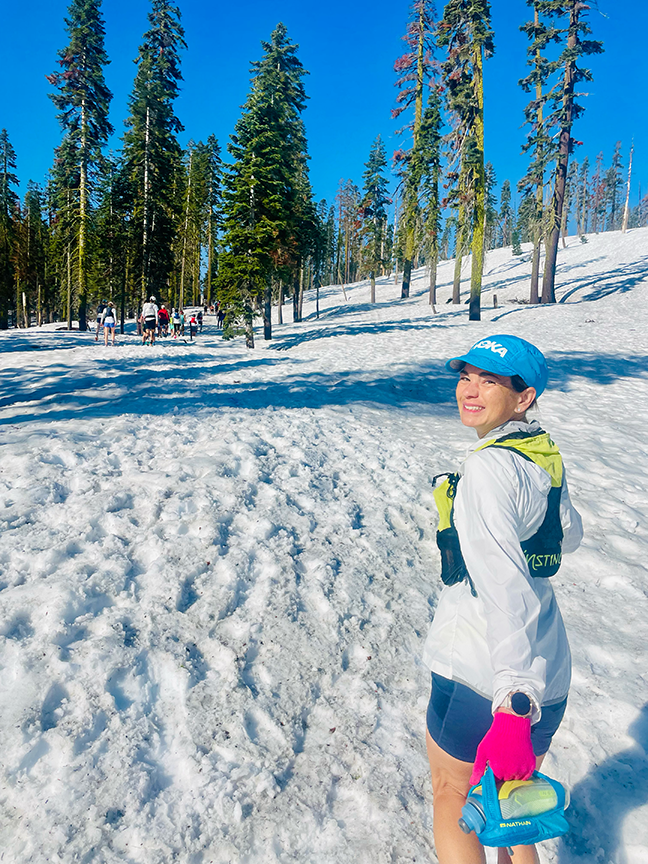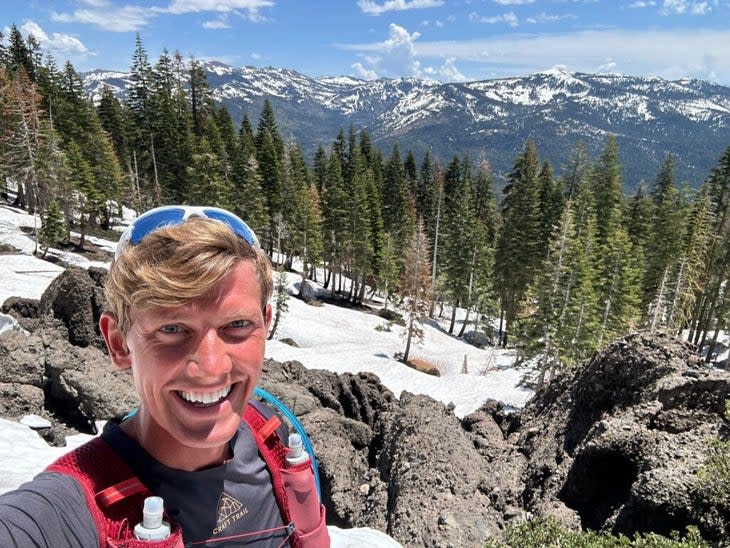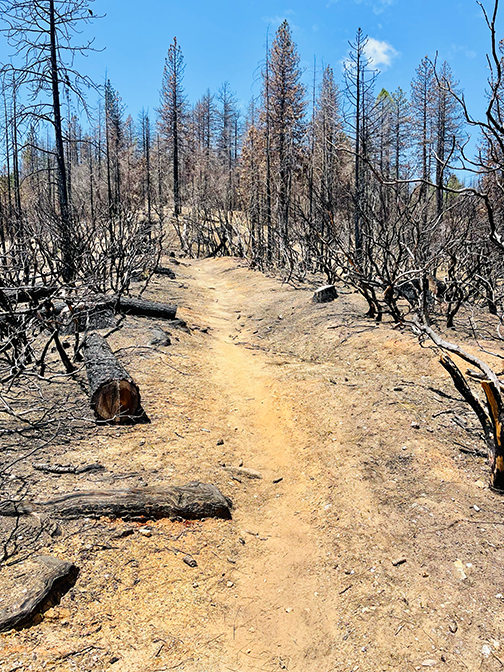Broken Arrow, Western States Runners Will Battle Snowy Conditions
This article originally appeared on Trail Runner
There will be some epic trail running races starting from California's Palisades at Tahoe resort in the next two weeks, but no doubt most of the runners will have to endure wet, cold feet from tromping through snow.A good amount of the massive snowfall that hit the Sierra Nevada mountain range over the winter and spring is still hanging around, but the show must go on. Both the June 16-18 Broken Arrow Skyrace and the June 24-25 Western States Endurance Run will be held as planned, and each of the races are likely to follow the originally intended courses.
RELATED: Yes, Western States Is Worth The Hype
Broken Arrow Still On Track Despite Snow
The seventh edition of the Broken Arrow Sky Race is expecting about 3,000 runners for its six races held at the resort.
"It’s been very warm and it's melting rapidly, but I always tell people that we started with 50 feet of snow on the crest, so there's a lot of it still here," says Brendan Madigan, founder and co-director of Broken Arrow Skyrace. "When we had our operations meeting with the resort a couple weeks ago, what they were telling me was the upper mountain might lose about 25 percent of the total. So that means the upper mountain will be completely covered in snow, which is something we’re used to, while the lower mountain will be a little spottier."

Broken Arrow has a Vertical Kilometer race, plus 11K, 23K, 46K trail races, a half-mile kids race, and a 5.75-mile Iron Face Challenge (which includes a section of the resort's via ferrata course), as well as the multi-race Triple Crown competition (VK, 23K, and 46K) and Iron Crown competition (23K, 46K and Iron Face Challenge). The only Broken Arrow race that might have modifications is the Iron Face event, due to safety considerations. Madigan said the Broken Arrow race team and the mountain operations crew at Palisades at Tahoe have been considering all the options and should announce a final assessment on June 12.
"I take a lot of pride in not canceling anything unless it’s absolutely necessary from a safety perspective," Madigan says. "We’ve got a great team that puts the work in to make it happen. For the via [ferrata], for instance, it’s our course marshals working very closely with Alpenglow Expeditions which runs the Tahoe Via Ferrata. There will be lots of chop steps cut and lots of man hours, lots of hand lines, but it’ll be an exceptional adventure for people."
Removable traction devices that can be attached to shoes are allowed in the Broken Arrow Skyrace events, but Madigan doesn't think any of the elite runners will use them. Trekking poles are allowed, too, but in both cases, if a runner starts with either of those items, they have to wear or carry them the entire way from start to finish.
"It’s really only the first few hours of the morning that those traction devices even make a difference," he says. "But for some people, it offers peace of mind, gives them a little bit of a mental boost. So traction is allowed but not required. We strongly encourage the use of poles because it makes such a big difference in conditions like these."

Lots of Snow Remains on Western States Course
The Western States 100 will send 381 runners on a journey from the base of the Palisades Tahoe ski slopes on its legendary 100-mile route to the Placer High School track down in Auburn. Runners will encounter significant snow on the course for much of the first 35 miles of the course, but trekking poles are prohibited in that race and the only traction allowed are shoes with built-in spikes. Strap-on crampon devices and shoes with screws drilled into the outsole are not allowed.
While there might be some dry spots near the start at the base of Palisades Tahoe resort, Western States runners will likely be running on snow for most of the first 15 miles. Runners will finally hit dry ground near the Red Star Ridge aid station at the 16-mile point of the race. They'll then run on dry terrain through Duncan Canyon, but then they'll encounter a few more miles of snow beginning at Robinson Flat near the 30-mile mark. After that, the route will be dry for most of the rest of the way, except for, of course, the Rucky Chucky American River crossing near mile 78. It will be mandatory that runners cross the river in boats this year, Thornley siad.
There will likely be some modifications to the routes crew and volunteers use to reach aid stations. Also, the race previously announced that there will be no crews allowed at the Duncan Canyon or Dusty Corners aid stations this year, but that's not because of snow. That's because Mosquito Ridge Road got washed out from the atmospheric rivers after last fall's 76,000-acre Mosquito Ridge Fire. The Western States race crew worked with volunteers and numerous agencies to help restore the trail after the fire last winter.

RELATED: After Mosquito Fire and Heavy Rains, Western States Trail Requires Serious Work
"Other than that, it should look the same, other than the fact that runners will be running on snow," said Western States race director Craig Thornley. "Those who know how to ski or have experience on snow and know what it’s like will do a whole lot better than people who have never been on snow. It’s not that elites can handle the snow and the back of the packers can’t; it's more the range of ability in the snow is all over the place."
Runners at the May 27-29 Western States 100 training camp started running at Robinson Flat and ran on snow for about six miles down the course on what was a 32-mile run to Foresthill.
"It was really fun. I mean, it’s just training and everybody’s having a good time and, you know, they’re slipping and sliding and people are falling a lot," says Katie Asmuth, who finished ninth in the race last year and is racing again this year. "But also the snow just really takes a lot out of you and uses all the muscles that you’re not used to using. It’s really exhausting, so race day is going to be a very long day. I don’t think there will be any records being set."
Arlen Glick, last year's third-place finisher, did a 22.7-mile training run on June 5 from Robinson Flat to Red Star Ridge to Duncan Canyon and was surprised at how much snow he encountered. The race installed a guide cable for runners to get across the raging waters of Duncan Creek, and Glick was glad to be able to utilize it.
"Not recommended solo!" Glick said in a Strava post. "While this may be the most beautiful loop you certainly don't want to come here in a hurry. Fortunately I had all day for this one. Very impossible to follow trail with this much snow, not sure if I spent more time looking for trail or looking at my tracker but great practice for race day."
The biggest snow-related challenge for the Western States staff and volunteer crew is creating access to the sections of the course east of Duncan Creek to conduct trail work and gain access points to aid stations. The road to the Lyon Ridge aid station (Mile 10.3) is supposed to be plowed soon, Thornley said, which would allow race crew to gain more access. Thornley said the snows of 2016-2017 remained challenging up until race weekend. For the 2017 event, race crews didn't penetrate the snow and reach Red Star Ridge until the Friday of race weekend.
"We’ve been through this before," Thornley said. "We try to cut the (fallen) trees off at the road because if the trees stay on the road, then the snow won’t melt where those trees are. So we have to get those trees out as soon as we can so that the sun can continue to melt, which is something we learned in 2017 after that winter's big snow."
Thornely says the race organization has numerous contingency plans, including a helicopter at the ready to drop supplies, if necessary. There is also a local four-wheel-drive club and Tahoe Nordic Search & Rescue that are willing to help.
"Hopefully we’ll be able to cut the snow out ourselves," he said. "I don’t anticipate that we wouldn’t be able to get supplies up to Lyon Ridge. It’s just the method is unknown at this point."
Aside from the logistical challenges clearing and preparing the course, the lingering snowpack is a good problem to have, Thornley said. He's been happy to see many local reservoirs at or near capacity this spring.
"For all of the fire danger we have, it's probably good to have it this way," he said. "Fire is real, and the droughts have been really devastating."
Boulder-based Brian Metzler has run more than 75,000 miles in his life, competing in every distance from 50 meters to 100 miles, running the Rim-to-Rim-to-Rim run across the Grand Canyon and back several times, racing pack burros on many occasions and going up Colorado's Longs Peak 20 times. In 2018, he ran the Great Wall of China, completed the Leadman series and ran a 100K in South Korea. He is the founding editor of Trail Runner and the author of "Kicksology: The Hype, Science, Culture and Cool of Running Shoes."
For exclusive access to all of our fitness, gear, adventure, and travel stories, plus discounts on trips, events, and gear, sign up for Outside+ today.

